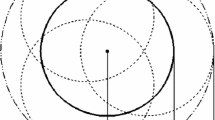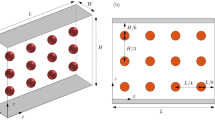Abstract
In a quiescent suspension, nanoparticles move randomly and thereby carry relatively large volumes of surrounding liquid with them. This micro-scale interaction may occur between hot and cold regions, resulting in a lower local temperature gradient for a given heat flux compared with the pure liquid case. Thus, as a result of Brownian motion, the effective thermal conductivity, keff, which is composed of the particles’ conventional static part and the Brownian motion part, increases to result in a lower temperature gradient for a given heat flux. To capture these transport phenomena, a new thermal conductivity model for nanofluids has been developed, which takes the effects of particle size, particle volume fraction and temperature dependence as well as properties of base liquid and particle phase into consideration by considering surrounding liquid traveling with randomly moving nanoparticles.
The strong dependence of the effective thermal conductivity on temperature and material properties of both particle and carrier fluid was attributed to the long impact range of the interparticle potential, which influences the particle motion. In the new model, the impact of Brownian motion is more effective at higher temperatures, as also observed experimentally. Specifically, the new model was tested with simple thermal conduction cases, and demonstrated that for a given heat flux, the temperature gradient changes significantly due to a variable thermal conductivity which mainly depends on particle volume fraction, particle size, particle material and temperature. To improve the accuracy and versatility of the keffmodel, more experimental data sets are needed.
Similar content being viewed by others
References
P. Bhattacharya S.K. Saha A. Yadav P.E. Phelan R.S. Prasher (2004) ArticleTitleBrownian dynamics simulation to determine the effective thermal conductivity of nanofluids J. Appl. Phys. 95 IssueID11 6492–6494
S. Chapman T.G. Cowling (1951) Mathematical Theory of Non-Uniform Gases EditionNumber2 Cambridge University Press Cambridge, UK
S. Choi (1995) ArticleTitleEnhancing thermal conductivity of fluids with nanoparticles FED 231 99–103
S. Choi Z. Zhang W. Yu F. Lockwood E. Grulke (2001) ArticleTitleAnomalously thermal conductivity enhancement in nanotube suspensions Appl. Phys. Lett. 79 IssueID14 2252–2254
S. Das N. Putra P. Thiesen W. Roetzel (2003) ArticleTitleTemperature dependence of thermal conductivity enhancement for nanofluids J. Heat Trans. 125 567–574
W.M. Deen (1998) Analysis of Transport Phenomena Oxford University Press New York, NY
J. Eastman S. Choi S. Li W. Yu L. Thompson (2001) ArticleTitleAnomalously increased effective thermal conductivities of ethylene glycol-based nanofluids containing copper/nanoparticles Appl. Phys. Lett. 78 718–720 Occurrence Handle10.1063/1.1341218
R. Hamilton O. Crosser (1962) ArticleTitleThermal conductivity of heterogeneous two-component systems I & EC Fundamentals 125 IssueID3 187–191
J. Israelachvili (1992) Intermolecular and Surface Forces EditionNumber2 Academic press Amsterdam
S. P. Jang S. U. S. Choi (2004) ArticleTitleRole of Brownian motion in the enhanced thermal conductivity of nanofluids Appl. Phys. Lett. 84 IssueID21 4316–4318
P. Keblinski S. Phillpot S. Choi J. Eastman (2002) ArticleTitleMechanisms of heat flow in suspensions of nano-sized particles (nanofluids) Int. J. Heat Mass Transfer 45 855–863
J. Koo (2004) Computational Nanofluid Flow and Heat Transfer Analyses as Applied to Micro-syslems North Carolina State University Raleigh, NC
S. Lee S. Choi S. Li J. Eastman (1999) ArticleTitleMeasuring thermal conductivity of fluids containing oxide nanoparticles J. Heat Transfer 121 280–289
J. Maxwell (1904) A Treatise on Electricity and Magnetism EditionNumber2 Oxford University Press Cambridge, UK
H. Patel S. Das T. Sundararajan A. Sreekumaran B. George T. Pradeep (2003) ArticleTitleThermal conductivities of naked and monolayer protected metal nanoparticle based nanofluids: Manifestation of anomalous enhancement and chemical effects Appl. Phys. Lett. 83 IssueID14 2931–2933
R. Probstein (2003) Physicochemical Hydrodynamics EditionNumber2 Wiley Inc. Hoboken, NJ
H. Xie H. Lee W. Youn M. Choi (2003) ArticleTitleNanofiuids containing multiwalled carbon nanotubes and their enhanced thermal conductivities J. Appl. Phys. 94 IssueID8 4967–4971
H. Xie J. Wang T. Xi Y. Liu F. Ai Q. Wu (2002) ArticleTitleThermal conductivity enhancement of suspensions containing nanosized alumina particles J. Appl. Phys. 91 IssueID7 4568–4572
Y. Xuan Q. Li (2000) ArticleTitleHeat transfer enhancement of nanofluids Int. J. Heat Fluid Flow 21 58–64
Q. Xue (2003) ArticleTitleModel for effective thermal conductivity of nanofluids Phys. Lett. A 307 313–317
W. Yu S. Choi (2003) ArticleTitleThe role of interfacial layers in the enhanced thermal conductivity of nanofluids: A renovated maxwell modelLanguage J. Nano. Res. 5 167–171
Author information
Authors and Affiliations
Corresponding author
Rights and permissions
About this article
Cite this article
Koo, J., Kleinstreuer, C. A new thermal conductivity model for nanofluids. J Nanopart Res 6, 577–588 (2004). https://doi.org/10.1007/s11051-004-3170-5
Received:
Accepted:
Published:
Issue Date:
DOI: https://doi.org/10.1007/s11051-004-3170-5




